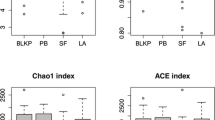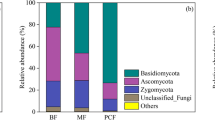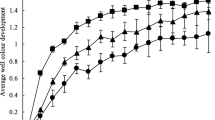Abstract
Soil erosion is a serious issue in the sandy-hilly region of Shanxi Province, Northwest China. There has been gradual improvement due to vegetation restoration, but soil microbial community characteristics in different vegetation plantation types have not been widely investigated. To address this, we analyzed soil bacterial and fungal community structures, diversity, and microbial and soil environmental factors in Caragana korshinskii Kom., Populus tomentosa Carr., Populus simonii Carr., Salix matsudana Koidz, and Pinus tabulaeformis Carr. forests. There were no significant differences in the dominant bacterial community compositions among the five forest types. The alpha diversity of the bacteria and fungi communities showed that ACE (abundance-based coverage estimator), Chao1, and Shannon indices in C. korshinskii forest were significantly higher than those in the other four forest types (P<0.05). Soil organic matter, total nitrogen, and urease had a greater impact on bacterial community composition, while total nitrogen, β-glucosidase, and urease had a greater impact on fungal community composition. The relative abundance of beneficial and pathogenic microorganisms was similar across all forest types. Based on microbial community composition, diversity, and soil fertility, we ranked the plantations from most to least suitable as follows: C. korshinskii, S. matsudana, P. tabulaeformis, P. tomentosa, and P. simonii.
Similar content being viewed by others
References
Chang Q R, Yue Q L. 2008. Soil fertility quality of artificial forest in the hilly-gully region of Loess Plateau. Science of Soil and Water Conservation, 6(2): 71–74, 94. (in Chinese)
Cui J, Huang J J, Chen Y M, et al. 2018. Biodiversity of herbaceous species under Caragana microphylla plantations in loess hilly region. Journal of Northwest Forestry University, 33(3): 14–20. (in Chinese)
Cui X C. 2021. Research progress on relationship between rhizosphere microorganisms and soil plants. Modern Agriculture Research, 27(5): 34–35, 49. (in Chinese)
Dai Y T, Yan Z J, Xie J H, et al. 2017. Soil bacteria diversity in rhizosphere under two types of vegetation restoration based on high throughput sequencing. Acta Pedologica Sinica, 54(3): 735–748. (in Chinese)
Deng J J, Zhu W X, Zhang Y, et al. 2020. Studies on soil fungal community composition and function characteristics of different plantations of sandy area, Northwest Liaoning Province. Forest Research, 33(1): 44–54.
Dong L L, Zheng F L. 2009. Effects land-use types on soil microbial characteristics and carbon density in the loessial hilly-gully region. Journal of Shaanxi Normal University (Natural Science Edition), 37(4): 88–94. (in Chinese)
Fu Q, Zhang G, Wang J, et al. 2008. Mechanism of formation of the heaviest pollution episode ever recorded in the Yangtze River Delta, China. Atmospheric Environment, 42(9): 2023–2036.
Ge S Z, Luo L, Niu J, et al. 2013. Effects of different nitrogen fertilizer on soil physical and chemical properties and microbial. Chinese Agricultural Science Bulletin, 29(36): 167–171. (in Chinese)
Guo Y Q. 2017. Dynamics of soil microbial communities in revegetation areas on the loess plateau of China. PhD. Dissertation. Yangling: Northwest Agriculture and Forestry University. (in Chinese)
Guo Z S, Shao M A. 2010. Effect of artificial Caragana korshinskii forest on soil water in the semiarid area of loess hilly region. Scientia Silvae Sinicae, 46(12): 1–7. (in Chinese)
He Z B, Zhao W Z, Qu L B. 2005. Protective effects of farmland protection forest in the middle reach of Heihe River. Chinese Journal of Ecology, 24(1): 79–82. (in Chinese)
Huang J, Zhu X Y, Lu J, et al. 2019. Effects of different land use types on microbial community diversity in the Shizishan mining area. Environmental Science, 40(12): 5550–5560.
Huang Y, Huang M K, Chai L W, et al. 2018. Drivers of the spatial patterns of soil microbial communities in arid and semi-arid regions. Ecology and Environmental Sciences, 27(1): 191–198. (in Chinese)
Jiao R L, Ren Y Z, Li G Y, et al. 2019. Identification of one new causal agent of cotton boll disease in cotton from Xinjiang Province. Cotton Science, 31(6): 474–481. (in Chinese)
Li M, Yao Q Z, Wei J, et al. 2018. Recent advances in cortinarius research. Acta Edulis Fungi, 25(3): 86–95. (in Chinese)
Liang H B, Shi J W, Niu J J, et al. 2014. Study on the characteristics of the soil moisture variation in different-aged Caragana korshinskii Kom. in loess hilly region, Northwestern Shanxi. Journal of Arid Land Resources and Environment, 28(6): 143–148. (in Chinese)
Liang X H, Zhang K B, Qiao X. 2019. Relationship between soil moisture and nutrients and plant diversity of Caragana microphylla community in semi-arid loess region. Ecology and Environmental Sciences, 28(9): 1748–1756. (in Chinese)
Liu J, Gou Q Q, Wang G H, et al. 2022. Changes of vegetation community and soil characteristics of 50 years old artificial Caragana korshinskii in sandy-hilly region of Northwest Shanxi Province. Journal of Soil and Water Conservation, 36(1): 219–230. (in Chinese)
Liu S H, Wang M Y, Wang J, et al. 2013. Analyzing soil microbial community structure diversity from Jianhu wetland lakeside zone using PCRDGGE technique. Journal of Agro-Environment Science, 32(7): 1405–1412. (in Chinese)
Liu SH, Wang Y, Liu B B, et al. 2019. Effects of different land management practices on soil carbon and nitrogen, enzyme activities, and microbial diversities northwest of Shanxi. Acta Ecologica Sinica, 39(12): 4376–4389.
Ning Q, Chen L, Li F, et al. 2022. Effects of mortierella on nutrient availability and straw decomposition in soil. Acta Pedologica Sinica, 59(1): 206–217. (in Chinese)
Niu X W, Zhang Q, Yang Z P, et al. 2003. Research on change of soil properities of Caragana plantation in North-west of Shanxi Province. Acta Botanica Boreali-Occidentalia Sinica, 23(4): 628–632. (in Chinese)
Peng W H, Yu W J, Li Y, et al. 2019. Inocybe soluta (Inocybaceae), an agaric species new to China. Journal of Jilin Forestry Science and Technology, 48(6): 21–24. (in Chinese)
Shu W W, Lu L H, Li H, et al. 2021. Effects of stand density on understory plantations and soil nutrients in Chinese fir plantation. Acta Ecologica Sinica, 41(11): 4521–4530.
Sun B J, Zhang X P, Jia S X. 2013. The effect of soil physical and chemical properties on soil microbial community in agro-ecosystem. Soils and Crops, 2(3): 138–144. (in Chinese)
Wang M B, Li H J. 1989. Study on soil water eco-environmental characteristics of artificial Caragana korshinskii plantation. Soil and Water Conservation in China, 10(1): 155–160. (in Chinese)
Wang T, Guo Y, Su J Y, et al. 2020. Effects of Syringa pinnatifolia var. alanshanica on soil physicochemical properties, enzyme activities and microbial diversity. Journal of Beijing Forestry University, 42(4): 91–101. (in Chinese)
Wang Y, Liu S, Guo J L, et al. 2018. Influence of different vegetation types on soil nutrients, enzyme activities and microbial diversities in Loess Plateau. Bulletin of Soil and Water Conservation, 38(1): 62–68. (in Chinese)
Wang Y, Guo M S, Gao G L, et al. 2021. Effect of inoculating with three ectotrophic mycorrhizal fungi on the growth of Pinus sylvestris var. mongolica seedlings. Journal of Arid Land Resources and Environment, 35(10): 135–140. (in Chinese)
Wu D H, Yin W Y, Bo Z Y. 2008. Changes among soil nematode community characteristics in relation to different vegetation restoration practices in the moderate degraded grasslands of Songnen. Acta Ecologica Sinica, 28(1): 1–12.
Wu Z, Haack S E, L W, et al. 2015. Soil microbial community structure and metabolic activity of Pinus elliottii plantations across different stand ages in a subtropical area. PLoS ONE, 10(8): 135354, doi: https://doi.org/10.1371/journal.pone.0135354.
Xi J Q, Yang Z H, Guo S J, et al. 2015. Effects of Haloxylon ammodendron planting on soil physico-chemical properties and soil microorganisms in sandy dunes. Acta Prataculturae Sinica, 24(5): 44–52. (in Chinese)
Xu C, Lei Z Y, Zhou F Y, et al. 2021. Effects of the growth of Pinus sylvestris var. mongolica plantation in sandy land on soil moisture in non-rainfall seasons. Chinese Journal of Ecology, 40(1): 58–66. (in Chinese)
Xu Y D, Wang T, Li H, et al. 2018. Soil enzyme activities and nutrient changes’ characteristics of Caragana korshinskii plantation in loess hilly region. Acta Agrestia Sinica, 26(2): 363–370. (in Chinese)
Yang Y H, Lv D, Zhang X P, et al. 2017. Impacts of vegetation types on soil physicochemical properties. Research of Soil and Water Conservation, 24(6): 238–242, 249. (in Chinese)
Yang Z J, Zeng J, Xu D P, et al. 2007. The processes and dominant factors of forest litter decomposition: A review. Ecology and Environment, 16(2): 649–654.
Yu W R N, Pan C H, Guo J H, et al. 2021. A study on organic carbon and nitrogen nutrients under Chinese fir plantation: Relationships with soil nutrients. Chinese Journal of Eco-Agriculture, 29(11): 1931–1939. (in Chinese)
Yu X, Liu X, Liu J L, et al. 2015. Evolution of soil microbial community structure under Hippophae rhamnoides plantations with different ages in the hilly and gully regions of the Loess Plateau. Journal of Northwest Forestry University, 30(5): 1–6. (in Chinese)
Zhang B C, Zhang Y Q, Li X Z, et al. 2018. Successional changes of fungal communities along the biocrust development stages. Biology and Fertility of Soils, 54: 285–294.
Zhang J E, Liu W G, Hu G. 2002. The relationship between quantity index of soil microorganisms and soil fertility of different land use systems. Soil and Environment, 11(2): 140–143. (in Chinese)
Zhang L, Gao H. 2000. Research status and advances of land degradation of artificial forests. South China Forestry Science, (6): 28–33. (in Chinese)
Zhang Q, Wang J Q, Lv M X, et al. 2019. The secondary mtabolites’ structure isolated from endophytic fungi of officinal activity. Industrial Microbiology, 49(2): 56–65.
Zhang Y H, Zhang J Q, Wang C. 2011. Impact on soil nutrient of Populus tomentosa and Robinia pseudoacaia plantations in loess plateau. Journal of Northwest Forestry University, 26(5): 12–17. (in Chinese)
Zhao G D, Liu S R, Jia R. 2004. Effects of seabuckthorn on soil moisture variation of poplar plantation in west area of Liaoning Province. Journal of Soil and Water Conservation, 18(5): 112–114. (in Chinese)
Zhao H, Zhou Y C, Ren Q F. 2020. Evolution of soil microbial community structure and functional diversity in Pinus massoniana plantations with age of stand. Acta Pedologica Sinica, 57(1): 227–238. (in Chinese)
Zhao N, Zha T G, Zhou Z Y. 2011. Effect of allocation of tree species on species diversity of forest floor in loess plateau of west Shanxi Province. Journal of Northeast Forestry University, 39(3): 44–45. (in Chinese)
Zhao W Z, Zheng Y, Zhang G F. 2018. Self-organization process of sand-fixing plantation in a desert-oasis ecotone, Northwestern China. Journal of Desert Research, 38(1): 1–7. (in Chinese)
Acknowledgements
This research was funded by the National Natural Science Foundation of China (42171033, 41807518, 41701045), the Shanxi Provincial Natural Science Foundation of China (201801D221336), and the Scientific and Technological Innovation Programs of Higher Education Institutions in Shanxi Province, China (2019L0457, 2019L0463). We thank Mr. John B BRADFORD and Dr. LIU Baoli for giving us so many good suggestions for this study.
Author information
Authors and Affiliations
Corresponding author
Rights and permissions
About this article
Cite this article
Gou, Q., Ma, G., Qu, J. et al. Diversity of soil bacteria and fungi communities in artificial forests of the sandy-hilly region of Northwest China. J. Arid Land 15, 109–126 (2023). https://doi.org/10.1007/s40333-023-0003-x
Received:
Revised:
Accepted:
Published:
Issue Date:
DOI: https://doi.org/10.1007/s40333-023-0003-x




